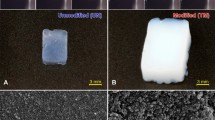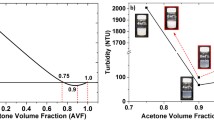Abstract
Organic aerogels based on resorcinol-formaldehyde gels display remarkable properties due to their pronounced nanoporosity. Therefore, studies towards the understanding of their structure-property-relationship are of high value for the design of improved materials. X-ray tomography is a technique that has been used for the structural elucidation of porous materials, but so far no highly resolved three-dimensional structures of resorcinol-formaldehyde gels have been obtained under the classical absorption-based experimental X-ray setup. This paper reports on the successful analysis of a superflexible resorcinol-formaldehyde aerogel using zoom holotomography that yielded images with an unprecedented resolution in the sub-micrometer range. The preparation of suitable powder from monolithic superflexible resorcinol-formaldehyde, the experimental conditions for tomography, and data-processing to obtain a 3D-image of the dried gel sample are described. Macropores above ca. 75 nm could be identified and visualized. They were shown to adopt almost spherical shape and to display a low connectivity. A quantitative analysis of the pore space revealed that most of the identified pores are small macropores (diameter < 0.5 µm), yet most pore volume is located in larger macropores of 1–4 µm diameter.
Graphical Abstract







Similar content being viewed by others
References
Aegerter MA, Leventis N, Koebel MM (eds) (2011) Aerogels handbook. Springer, New York, NY
Lu X, Arduini-Schuster MC, Kuhn J, Nilsson O, Fricke J, Pekala RW (1992) Thermal conductivity of monolithic organic aerogels. Science 255(5047):971–972
Pekala RW, Alviso CT, LeMay JD (1990) Organic aerogels: microstructural dependence of mechanical properties in compression. J Non Cryst Solids 125(1–2):67–75
Lu X, Caps R, Fricke J, Alviso CT, Pekala RW (1995) Correlation between structure and thermal conductivity of organic aerogels. J Non Cryst Solids 188(3):226–234
Reichenauer G (2011) Structural characterization of aerogels. In: Aegerter MA, Leventis N, Koebel MM (eds) Aerogels handbook. Springer, New York, NY, p 449–498
Barrett EP, Joyner LG, Halenda PP (1951) The determination of pore volume and area distributions in porous substances. I. computations from nitrogen isotherms. J Am Chem Soc 73(1):373–380
Fu B, Luo H, Wang F, Churu G, Chu KT, Hanan JC, Sotiriou-Leventis C, Leventis N, Lu H (2011) Simulation of the microstructural evolution of a polymer crosslinked templated silica aerogel under high-strain-rate compression. J Non Cryst Solids 357(10):2063–2074
Rege A, Schestakow M, Karadagli I, Ratke L, Itskov M (2016) Micro-mechanical modelling of cellulose aerogels from molten salt hydrates. Soft Matter 12(34):7079–7088
Reichenauer G, Scherer GW (2000) Nitrogen adsorption in compliant materials. J Non Cryst Solids 277(2–3):162–172
Landers J, Gor GY, Neimark AV (2013) Density functional theory methods for characterization of porous materials. Colloids Surf A 437:3–32
Giesche H (2006) Mercury porosimetry: a general (practical) overview. Part Part Syst Charact 23(1):9–19
Johnston GP, Smith DM, Melendez I, Hurd AJ (1990) Compression effects in mercury porosimetry. Powder Technol 61(3):289–294
Scherer GW, Smith DM, Stein D (1995) Deformation of aerogels during characterization. J Non Cryst Solids 186:309–315
Holzer L, Indutnyi F, Gasser PH, Münch B, Wegmann M (2004) Three-dimensional analysis of porous BaTiO3 ceramics using FIB nanotomography. J Microsc 216(1):84–95
Wilson JR, Kobsiriphat W, Mendoza R, Chen H-Y, Hiller JM, Miller DJ, Thornton K, Voorhees PW, Adler SB, Barnett SA (2006) Three-dimensional reconstruction of a solid-oxide fuel-cell anode. Nat Mater 5(7):541–544
Ziegler C, Thiele S, Zengerle R (2011) Direct three-dimensional reconstruction of a nanoporous catalyst layer for a polymer electrolyte fuel cell. J Power Sources 196(4):2094–2097
Balach J, Miguel F, Soldera F, Acevedo DF, Mücklich F, Barbero CA (2012) A direct and quantitative image of the internal nanostructure of nonordered porous monolithic carbon using FIB nanotomography. J Microsc 246(3):274–278
Balach J, Soldera F, Acevedo DF, Mücklich F, Barbero CA (2013) A direct and quantitative three-dimensional reconstruction of the internal structure of disordered mesoporous carbon with tailored pore size. Microsc Microanal 19(3):745–750
Maire E (2012) X-ray tomography applied to the characterization of highly porous materials. Annu Rev Mater Res 42(1):163–178
Haghgoo M, Plougonven E, Yousefi AA, Pirard J-P, Léonard A, Job N (2012) Use of X-ray microtomography to study the homogeneity of carbon nanotube aqueous suspensions and carbon nanotube/polymer composites. Carbon 50(4):1703–1706
Laskowski J (2016) Synthese und eigenschaften von Aerogel-Aerogel-Verbundwerkstoffen. Dissertation, Rheinisch-Westfälische Technische Hochschule Aachen
Mokso R, Cloetens P, Maire E, Ludwig W, Buffière J-Y (2007) Nanoscale zoom tomography with hard x rays using Kirkpatrick-Baez optics. Appl Phys Lett 90(14):144104
Kenesei P, Biermann H, Borbély A (2005) Structure–property relationship in particle reinforced metal–matrix composites based on holotomography. Scr Mater 53(7):787–791
Girardin E, Renghini C, Dyson J, Calbucci V, Moroncini F, Albertini G (2011) Characterization of porosity in a laser sintered MMCp using X-ray synchrotron phase contrast microtomography. Mater Sci Appl 2:1322–1330
Sar J, Celikbilek O, Villanova J, Dessemond L, Martin CL, Djurado E (2015) Three dimensional analysis of Ce0.9Gd0.1O1.95–La0.6Sr0.4Co0.2Fe0.8O3−δ oxygen electrode for solid oxide cells. J Eur Ceram Soc 35(16):4497–4505
Hubert M, Laurencin J, Cloetens P, da Silva JC, Lefebvre-Joud F, Bleuet P, Nakajo A, Siebert E (2016) Role of microstructure on electrode operating mechanisms for mixed ionic electronic conductors: from synchrotron-based 3D reconstruction to electrochemical modeling. Solid State Ion 294:90–107
Cloetens P, Mache R, Schlenker M, Lerbs-Mache S (2006) Quantitative phase tomography of arabidopsis seeds reveals intercellular void network. Proc Natl Acad Sci USA 103(39):14626–14630
Schwan M, Tannert R, Ratke L (2016) New soft and spongy resorcinol–formaldehyde aerogels. J Supercrit Fluids 107:201–208
Pekala RW, Kong FM (1989) A Synthetic route to organic aerogels - mechanism, structure, and properties. J Phys 50(C-4):C433–C440
Brunauer S, Emmett PH, Teller E (1938) Adsorption of gases in multimolecular layers. J Am Chem Soc 60(2):309–319
Heyn E (1903) Short reports from the metallurgical laboratory of the royal mechanical and testing institute of Charlottenburg. Metallographist 6:39–70
Zabler S, Cloetens P, Guigay J-P, Baruchel J, Schlenker M (2005) Optimization of phase contrast imaging using hard x rays. Rev Sci Instrum 76(7):073705
Labiche J-C, Mathon O, Pascarelli S, Newton MA, Ferre GG, Curfs C, Vaughan G, Homs A, Carreiras DF (2007) Invited article: the fast readout low noise camera as a versatile x-ray detector for time resolved dispersive extended x-ray absorption fine structure and diffraction studies of dynamic problems in materials science, chemistry, and catalysis. Rev Sci Instrum 78(9):091301
Cloetens P, Ludwig W, Baruchel J, Van Dyck D, Van Landuyt J, Guigay JP, Schlenker M (1999) Holotomography: Quantitative phase tomography with micrometer resolution using hard synchrotron radiation x rays. Appl Phys Lett 75(19):2912–2914
Bracewell RN, Riddle AC (1967) Inversion of fan-beam scans in radio astronomy. Astron J 150(2):427–434
Piedboeuf M-LC, Léonard AF, Traina K, Job N (2015) Influence of the textural parameters of resorcinol–formaldehyde dry polymers and carbon xerogels on particle sizes upon mechanical milling. Colloids Surf A 471:124–132
Tannert R, Schwan M, Ratke L (2015) Reduction of shrinkage and brittleness for resorcinol-formaldehyde aerogels by means of a pH-controlled sol–gel process. J Supercrit Fluids 106:57–61
Moreno-Castilla C, Carrasco-Marín F, Dawidziuk M (2012) Carbon aerogel-supported Pt catalysts for the hydrogenolysis and isomerization of n-Butane: influence of the carbonization temperature of the support and Pt particle size. Catalysts 2(4):422
Wickenheisser M, Herbst A, Tannert R, Milow B, Janiak C (2015) Hierarchical MOF-xerogel monolith composites from embedding MIL-100(Fe,Cr) and MIL-101(Cr) in resorcinol-formaldehyde xerogels for water adsorption applications. Microporous Mesoporous Mater 215:143–153
Acknowledgements
The authors wish to thank Benjamin Ignatzi for the production and characterization of powders and Guillermo Requena and Galina Kasperovich for assistance and computer resources provided during preliminary image analysis. We thank the European Synchrotron Radiation Facility for access to synchrotron radiation facilities at ID16A beamline (proposal SC4154 granted to RT, MS, AR, BM, M I, and LR). Financial support from the German Aerospace Center (program “Terrestrial vehicles”, project “Next Generation Car” for RT, MS, BM, and LR) is gratefully acknowledged.
Author information
Authors and Affiliations
Corresponding author
Ethics declarations
Conflict of interest
The authors declare that they have no competing interests.
Rights and permissions
About this article
Cite this article
Tannert, R., Schwan, M., Rege, A. et al. The three-dimensional structure of flexible resorcinol-formaldehyde aerogels investigated by means of holotomography. J Sol-Gel Sci Technol 84, 391–399 (2017). https://doi.org/10.1007/s10971-017-4363-6
Received:
Accepted:
Published:
Issue Date:
DOI: https://doi.org/10.1007/s10971-017-4363-6




